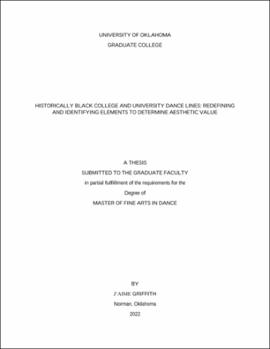| dc.description.abstract | This research study identifies the elements that combine to define the HBCU dance line aesthetic as an Africanist dance aesthetic, European dance aesthetic, and influences of male embodied femininity. Dance lines, the group of dancers that perform during the football games with the marching band at Historically Black Colleges and Universities (HBCUs), are an ever-evolving subculture within the larger HBCU culture. The Africanist dance dominates the HBCU dance line aesthetic and should be viewed through that lens. To avoid dismissing the growing interest in European dance seen in the use of tricks in their field show choreography, the HBCU dance line community should study the root of the trick, the technique, approaching the tricks from the lens of a European dance aesthetic. As these dance lines gain attention outside of their community, it is now more important than ever to define and document to preserve the aesthetic so that it is not lost and misinterpreted. When viewing and judging a community and its dance, it is vital to consider the history and context. The Southwestern Athletic Conference (SWAC) set the standard in 1968 when Mississippi’s Alcorn State University Golden Girls were the first to drop their batons and dance, paving the way. In this study, the discovery of the Africanist dance aesthetic via Jackson State University Prancing J-Settes and the European dance aesthetic via Grambling State University Orchesis Dance Company is presented through an analysis of interviews conducted with current and former HBCU dancers and directors, an observation of video content on YouTube and social media, and my personal experience as an HBCU dancer and concert dancer. Lastly, to investigate male embodied femininity visible in HBCU dance lines, I interviewed and was coached in person by two male hip hop majorette coaches and choreographers. | en_US |
